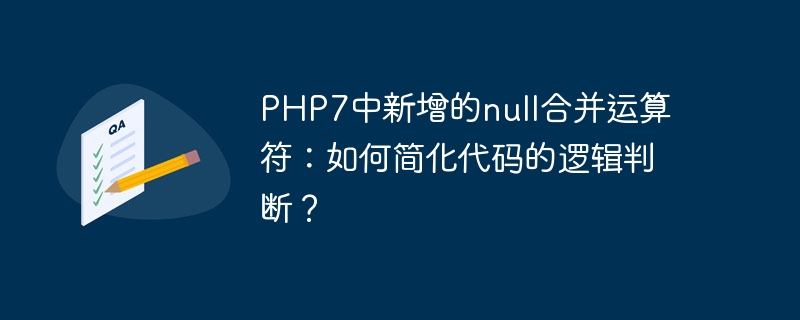 Backend Development
Backend Development
 PHP7
PHP7
 The new null coalescing operator in PHP7: How to simplify the logical judgment of the code?
The new null coalescing operator in PHP7: How to simplify the logical judgment of the code?
The new null coalescing operator in PHP7: How to simplify the logical judgment of the code?

A very practical operator has been added to PHP7: null coalescing operator. This operator can be used to simplify logical judgments in the code, making the code more concise and readable.
Traditional logical judgment is usually implemented using the ternary operator or if-else statement. For example, if we want to get the value of a variable, if the variable exists, the value of the variable will be used, otherwise the default value will be used. Before PHP7, we might write code like this:
$value = isset($variable) ? $variable : $default;
Such code looks cumbersome and not intuitive enough. Using the null merging operator can make the code more concise and clear:
$value = $variable ?? $default;
Use the null merging operator. If $variable exists and is not null, the value of $variable is used; otherwise, the value of $default is used. . This one line of code is enough, greatly reducing the complexity of the code.
In addition to simplifying logical judgments, the null coalescing operator can also be used to obtain values in an array. For example, we want to get the value corresponding to a key in the array. If the key exists, use its value, otherwise use the default value. Before PHP7, we might write code like this:
$value = isset($array['key']) ? $array['key'] : $default;
And using the null coalescing operator, we can write like this:
$value = $array['key'] ?? $default;
Similarly, such code is more concise and clear.
null The merge operator can be used in multiple nestings to meet complex logical judgment and value requirements. For example, we want to get the attribute value of an object, but the attribute may not exist, and the object itself may not exist. Before PHP7, we might need to write code like this:
$value = (isset($object) && isset($object->attribute)) ? $object->attribute : $default;
Now, we can simplify it to this:
$value = $object->attribute ?? $default;
Of course, if the nested logic is more complex, we still need to use the traditional if-else statement to handle.
It should be noted that the null coalescing operator only determines whether the variable is null, not whether the variable exists or is empty. If you just want to determine whether a variable exists or is empty, you still need to use the isset() or empty() function.
To sum up, the new null coalescing operator in PHP7 can greatly simplify the logical judgment in the code, making the code more concise and easier to read. However, when using it, you need to pay attention to the usage scenarios and restrictions of the operator to avoid unnecessary errors.
The above is the detailed content of The new null coalescing operator in PHP7: How to simplify the logical judgment of the code?. For more information, please follow other related articles on the PHP Chinese website!

Hot AI Tools

Undresser.AI Undress
AI-powered app for creating realistic nude photos

AI Clothes Remover
Online AI tool for removing clothes from photos.

Undress AI Tool
Undress images for free

Clothoff.io
AI clothes remover

AI Hentai Generator
Generate AI Hentai for free.

Hot Article

Hot Tools

Notepad++7.3.1
Easy-to-use and free code editor

SublimeText3 Chinese version
Chinese version, very easy to use

Zend Studio 13.0.1
Powerful PHP integrated development environment

Dreamweaver CS6
Visual web development tools

SublimeText3 Mac version
God-level code editing software (SublimeText3)

Hot Topics
 1359
1359
 52
52
 CakePHP Project Configuration
Sep 10, 2024 pm 05:25 PM
CakePHP Project Configuration
Sep 10, 2024 pm 05:25 PM
In this chapter, we will understand the Environment Variables, General Configuration, Database Configuration and Email Configuration in CakePHP.
 PHP 8.4 Installation and Upgrade guide for Ubuntu and Debian
Dec 24, 2024 pm 04:42 PM
PHP 8.4 Installation and Upgrade guide for Ubuntu and Debian
Dec 24, 2024 pm 04:42 PM
PHP 8.4 brings several new features, security improvements, and performance improvements with healthy amounts of feature deprecations and removals. This guide explains how to install PHP 8.4 or upgrade to PHP 8.4 on Ubuntu, Debian, or their derivati
 CakePHP Date and Time
Sep 10, 2024 pm 05:27 PM
CakePHP Date and Time
Sep 10, 2024 pm 05:27 PM
To work with date and time in cakephp4, we are going to make use of the available FrozenTime class.
 CakePHP File upload
Sep 10, 2024 pm 05:27 PM
CakePHP File upload
Sep 10, 2024 pm 05:27 PM
To work on file upload we are going to use the form helper. Here, is an example for file upload.
 CakePHP Routing
Sep 10, 2024 pm 05:25 PM
CakePHP Routing
Sep 10, 2024 pm 05:25 PM
In this chapter, we are going to learn the following topics related to routing ?
 Discuss CakePHP
Sep 10, 2024 pm 05:28 PM
Discuss CakePHP
Sep 10, 2024 pm 05:28 PM
CakePHP is an open-source framework for PHP. It is intended to make developing, deploying and maintaining applications much easier. CakePHP is based on a MVC-like architecture that is both powerful and easy to grasp. Models, Views, and Controllers gu
 CakePHP Working with Database
Sep 10, 2024 pm 05:25 PM
CakePHP Working with Database
Sep 10, 2024 pm 05:25 PM
Working with database in CakePHP is very easy. We will understand the CRUD (Create, Read, Update, Delete) operations in this chapter.
 CakePHP Creating Validators
Sep 10, 2024 pm 05:26 PM
CakePHP Creating Validators
Sep 10, 2024 pm 05:26 PM
Validator can be created by adding the following two lines in the controller.



